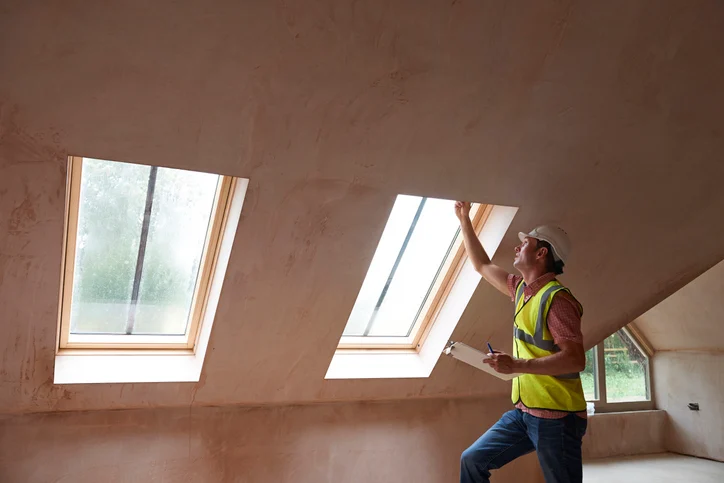
When something seems off with your car.
Or when a major household appliance is on the fritz.
Better yet, your computer has stopped working altogether.
Talk to any repair technician and their answer is usually something to the effect of, “I need to take a look at it.”
While that response is pretty standard, there is something to it – it’s impossible to know what needs fixing or adjustment without first seeing what’s malfunctioning. In short, getting a visual goes a long way.
The same goes for moisture surveys from home inspections to water and flood damage restoration. As part of an overall investigation, a visual inspection sets the stage for the rest of a moisture survey and its results are often invaluable to remediation or repair efforts.
Visual Inspections & the First Part of a Moisture Survey
Walk into any space potentially affected by moisture – say, a home inspection for water damage – and it’s natural to look around. It’s hard not to, especially when it’s somewhere you’ve never been.
Sometimes, evidence of moisture presence is hard to miss (more on that later), while other times, only a trained eye can notice apparent signs of a moisture issue.
Regardless, a visual inspection should always be the first component of a moisture survey, whether part of a home moisture inspection or for flood damage restoration.
By itself, a visual inspection is a means to get a sense of a space – or building – that’s affected by moisture. It’s also a rudimentary means to identify obvious areas of concern. However, as part of broader efforts to gauge moisture presence within a space, the visual survey is part of a much deeper investigation. Its results act as a guide for where the rest of a moisture investigation starts.
Done carefully, a visual inspection saves time in completing a full moisture survey. Rather than taking moisture readings arbitrarily and hoping that random spots yield results, an inspector can efficiently move through a space, starting with identified problem areas first.
Where’s the Most Important Place to Check for Moisture After a Flood?

|
Signs of Moisture to Look for During a Visual Inspection
A visual inspection goes beyond walking into a space and simply looking around.
Certainly, the first impression of a space is a component of a visual inspection. However, a glance over things is rarely sufficient. Rather, a visual inspection should be treated as a scouting mission of sorts to identify problem areas and immediately apparent signs of moisture.
When conducting a visual assessment, telltale signs of a moisture issue that merit further investigation include:
- Saturated walls and ceilings – among the most obvious signs and indicative of a serious and recent moisture issue.
- Surface-level condensation – a byproduct of temperature differences between a material and a space’s ambient conditions
- Water stains – typically seen on plaster and sheetrock ceilings and walls, water spots are usually the remnants of past moisture infiltration
- Mold & mildew – two fungi that are health hazards and thrive in excessive moisture
- Recession lines – usually spotted on walls, these lines show how high flood waters reached in a space
- Wet carpet – carpet exposed to excessive moisture doesn't have to be sopping wet – carpeting that appears damp may indicate a ground-level moisture issue.
- Hardwood floor cupping or crowning – a form of damage to wood that’s been exposed to excessive moisture and equilibrated to ambient conditions
Visual Inspections & the Last Part of a Moisture Survey
The results of a visual moisture inspection aren’t meant to serve one purpose. Rather, they are a critical part of the last portion of a moisture survey – the final report.
All data and information collected during the moisture survey are important. While moisture meter readings provide evidence of moisture presence, observations put context to those measurements. Combined with pictures taken during an inspection and there’s little room for questions about the extent of moisture presence in a space as presented in a water damage assessment report. What’s more, a visual inspection and pictures serve as a means to justify moisture meter measurements. With visual evidence taken during a water damage inspection, moisture readings have a secondary means for confirmation.
Aside from the property owner, the results of a visual inspection coupled with measurements taken during the moisture survey are of particular interest to insurers considering a claim. With moisture meter readings, visuals, and an explanation of both, an insurer doesn’t need to visit a site to understand the severity of a moisture issue.
Moisture Surveys & Visual Inspections: Two Sides of the Same Coin
A complete moisture inspection doesn’t solely rely on readings taken by a moisture meter. While those measurements are key information, they’re part of providing a full assessment of moisture presence and damage.
A visual inspection is not only a means to understand moisture infiltration and start a survey on the right foot, but also provides a holistic assessment of a flood or water damage incident’s impact.
Cover All Your Bases During a Moisture Inspection
Download our guide, “How to Measure Moisture in Buildings,” today:
